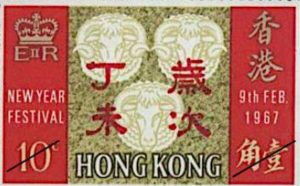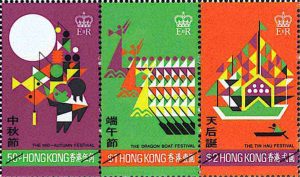Today we are introducing an article ‘Stamping “Imagination and Sensibility”: Objects, Culture, and Governance in Late Colonial Hong Kong’, by Allan T. F. Pang, University of Cambridge.
In August 1970, a quarrel about pigs arose between the Foreign and Commonwealth Office (FCO) and the Hong Kong government. Colonial officials had submitted designs of postage stamps commemorating the Lunar Year of the Pig, which would begin in January 1971. However, Secretary of State for Foreign and Commonwealth Affairs Alec Douglas-Home rejected this outright: the pig image was in ‘bad taste’. Governor David Trench defended the design. Hong Kong people treasured the Lunar New Year stamps, he argued, and discontinuing this series would lead to public discontent. ‘Regret I do not consider it feasible to produce a satisfactory design commemorating the Year of the Pig without incorporating a pig’, Trench replied in a telegraph, ‘and I also do not consider it possible to explain the absence of a 1971 commemorative issue without causing much comment and some ridicule’. London and Hong Kong officials eventually compromised. After understanding the local importance of the stamps, Douglas-Home softened his tone and explained that he simply objected to the design, not the issue. Local officials accommodated Douglas-Home’s taste by replacing the local Chinese pig with a boar.
This article argues that the colonial government used postage stamps and coins to demonstrate its care for local customs and shape public opinion. The government aimed to bridge the communication gap between society and the state by featuring Chinese culture on these everyday objects. It also utilized people’s cultural attachment to China to create a benevolent image of itself.
The context for this colonial policy included local events and Anglo-Chinese diplomacy. Riots in the late 1960s highlighted the need to address social discontent and close the communication gap. The British and colonial governments recognized that Hong Kong’s future lay with the People’s Republic of China (PRC) and sought to maintain the status quo while discussing the colony’s future with Chinese leaders.
Governor Murray MacLehose, who took office in 1971, devised strategies to safeguard British interests in future negotiations regarding Hong Kong. He aimed to make conditions in Hong Kong superior to those in China to discourage absorption by the Central People’s Government. This strategy included improvements in housing, education, and cultural development.
The colonial officials utilized Chinese culture to improve relations with the local population, many of whom had a cultural attachment to China. They recognized the importance of preserving Chinese customs and countering Chinese patriotism. Local leaders and social figures expressed their attachment to Chinese culture, and the younger generation demanded recognition of Chinese language and protested against Japan’s territorial claims.
The colonial government incorporated Chinese symbols into postage stamps and coins, working with the Crown Agents and the Royal Mint. By doing so, they aimed to secure people’s trust and support by aligning with the local population’s cultural preferences.
本文主張殖民政府利用郵票和硬幣來展示其對當地習俗的關懷,並塑造公眾輿論。政府旨在通過在這些日常物品上展示中國文化,拉近社會和英國之間的溝通差距。它還利用人們對中國的文化情感來創造自己的仁慈形象。
這種殖民政策的背景包括當地事件和中英外交。上世紀60年代末的暴動凸顯了解決社會不滿並拉近溝通差距的需要。英國和殖民政府認識到,香港的未來與中華人民共和國(PRC)息息相關,並在與中國領導人討論殖民地未來時力圖維持現狀。
1971年上任的港督麥理浩Murray MacLehose制定了在關於香港前途談判中保護英國利益的策略。他打算讓香港的環境發展得更好、優於中國,以防止被中央人民政府控制下中國兼併。策略包括改善住房、教育和文化發展。
許多香港人民對中國有文化情感,殖民官員利用中國文化改善與當地人民的關係。他們認識到保護中國習俗的重要,並以此對抗中國的愛國主義。當地領袖和社會人物表達他們對中國文化的情感依附,年輕一代要求承認中文成為法定語文並抗議日本的領土主張。
殖民政府與皇家代理人和皇家鑄幣廠合作,將中國象徵融入郵票和硬幣。它們希望透過迎合當地人民的文化偏好來獲得人們的信任和支持。
Photo and article source:
Allan T. F. Pang, Stamping ‘Imagination and Sensibility’: Objects, Culture, and Governance in Late Colonial Hong Kong







